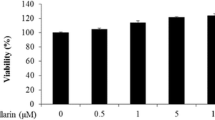Abstract
A novel marine active polypeptide (PCF), isolated from the gonochoric Chinese scallop, Chlamys farreri, has potential antioxidant and anti-apoptotic activity against ultraviolet irradiation. We investigated whether UVB-induced HaCaT cell apoptosis occurs via the mitochondrial pathways Apaf-1/caspase-9 and Smac/XIAP/caspase-3. We then investigated the molecular mechanisms controlling the anti-apoptotic effect of PCF. Pre-treatment with PCF and caspase-9 inhibitor significantly inhibited UVB-induced apoptosis in HaCaT cells based on a DNA fragmentation assay and Hoechst 33258 staining. The expression of Apaf-1 and the cleavage of procaspase-9 were dose-dependently reduced by 1.42–5.96 mmol/L PCF pretreatment in UVB-irradiated HaCaT cells. This was followed by inhibition of cleavage of procaspase-3, whose activation induced cell apoptosis. Meanwhile, PCF significantly and dose-dependently enhanced the activation of ATPase. Furthermore, we demonstrated that PCF strongly inhibited the release of Smac from the mitochondria to cytosol by reducing the degradation of XIAP dose-dependently. We conclude that the protective effect of PCF against UVB irradiation in HaCaT cells may be attributed to the inhibition of the Apaf-1/caspase-9 and Smac/XIAP/caspase-3 apoptotic signaling pathways.
Similar content being viewed by others
References
Adrain C, Martin S J. 2001. The mitochondrial apoptosome: A killer unleashed by the cytochrome seas. Trends Biochem Sci., 26: 390–397.
Bratton S B, Cohen G M. 2001. Apoptotic death sensor: an organelle’s alter ego? Trends Pharmacol Sci., 22: 306–315.
Chai J, Du C, Wu J W, Kyin S, Wang X, Shi Y. 2000. Structural and biochemical basis of apoptotic activation by Smac / DIABLO. Nature, 406: 855–862.
Deveraux Q L, Reed J C. 1999. IAP family proteins-suppressors of apoptosis. Genes Dev, 13: 239–252.
Deveraux Q L, Roy N, Stennicke H R, Van Arsdale T, Zhou Q, Srinivasula S M, Alnemri E S, Salvesen G S, Reed J C. 1998. IAPs block apoptotic events induced by caspase-8 and cytochrome c by direct inhibition of distinct caspases. J. Embo., 17: 2 215–2 223.
Du C, Fang M, Li Y, Li L, Wang X. 2000. Smac, a mitochondrial protein that promotes cytochrome c-dependent caspase activation by eliminating IAP inhibition. Cell, 102: 33–42.
Ekert P G, Silke J, Hawkins C J, Verhagen A M, Vaux D L. 2001. J. Cell Biol., 152, 483–490.
Kim H E, Jiang X, Du F, Wang X. 2008. PHAPI, CAS, and Hsp 70 promote apoptosome formation by preventing Apaf-1 aggregation and enhancing nucleotide exchange on Apaf-1. Mol. Cell., 30(2): 239–47.
Li B H, Zhou Y B, Guo S B, Wang C B. 2007. Polypeptide from Chlamys farreri inhibits UVB-induced HaCaT cells apoptosis via inhibition CD95 pathway and reactive oxygen species. Free Radic Res., 41(11): 1 224–1 232.
Li P, Nijhawan D, Budihardjo I, Srinivasula S M, Ahmad M, Alnemri E S, Wang X. 1997. Cytochrome c and dATP dependent formation of Apaf-1/caspase-9 complex initiates an apoptotic protease cascade. Cell, 91: 479–489.
Murphy G, Young A R, Wulf H C, Kulms D, Schwarz T. 2001. The molecular determinants of sunburn cell formation. Exp. Dermatol. 10: 155–160.
Nilkantha Sen, Benu Brata Das, Agneyo Ganguly, Tanmoy Mukherjee, Santu Bandyopadhyay, Hemanta K. Majumder. 2004. Camptothecin-induced Imbalance inIntracellular Cation Homeostasis Regulates Programmed Cell Death in Unicellular Hemoflagellate Leishmania donovani. J. Biol. Chem., 279(50): 523 66–52 375.
Riedl S J, Salvesen G S. 2007. The apoptosome: signaling platform for cell death, Nat. Rev. Mol. Cell Biol, 8: 405–413.
Shimizu S, Narita M, Tsujimoto Y. 1999. Bcl-1 family proteins regulate the release of apoptogenic cytochrome c by the mitochondrial channel VDAC. Nature, 399: 483–487.
Sitailo L A, Tibudan S S, Denning M F. 2002. Activation of caspase-9 is required for UV-induced apoptosis of human keratinocytes. J. Biol. Chem. 277: 19 346–19 352.
Soengas M S, Alarcon R M, Yoshida H, Giaccia A J, Hakem R, Mak T W, Lowe S W. 1999. Apaf-1 and caspase-9 in p53-dependent apoptosis and tumor inhibition. Science, 284(5411): 156–159.
Steller H. 1995. Mechanisms and genes of cellular suicide. Science, 267: 1 445–1 449.
Suzuki Y, Takahashi-Niki K, Akagi T, Hashikawa T, Takahashi R. 2004. Mitochondrial protease Omi/HtrA2 enhances caspase activation through multiple pathways. Cell Death and Differentiation, 11: 208–216.
Takasawa R, Nakamura H, Mori T, Tanuma S. 2005. Differential apoptotic pathways in human keratinocyte HaCaT cells exposed to UVB and UVC. Apoptosis, 10: 1 121–1 130.
Takasawa R, Tanuma S. 2003. Sustained release of Smac/DIABLO from mitochondria commits to undergo UVB-induced apoptosis. Apoptosis, 8: 291–299.
Wang C B, Huang M Q, Tao G L, Yu G Y, Han Z W, Yang Z H, Wang Y J. 2004. Polypeptide from Chlamys farreri protects HaCaT cells from UVB-induced apoptosis. Chemico-Biological Interactions, 147: 119–127.
Wang X Q, Xiao A Y. Christian S, Krzystztof H, Yang A Z, Goldberg M P., Choi D W, Yu S P. 2003. Apoptotic insults impair Na+, K+-ATPase activity as a mechanism of neuronal death mediated by concurrent ATP deficiency and oxidant stress. J. Cell Science, 116: 2 099–2 110
Author information
Authors and Affiliations
Corresponding author
Additional information
Supported by the National Natural Science Foundation of China (No. 30471458), and the Natural Science Foundation of Shandong Province, China (No. Z2007c09)
Rights and permissions
About this article
Cite this article
Liu, X., Wang, W., Wang, H. et al. A polypeptide from Chlamys farreri inhibits UVB-induced HaCaT cells apoptosis via the Apaf-1/caspase-9 and Smac/XIAP signaling pathway. Chin. J. Ocean. Limnol. 27, 587–593 (2009). https://doi.org/10.1007/s00343-009-9179-y
Received:
Accepted:
Published:
Issue Date:
DOI: https://doi.org/10.1007/s00343-009-9179-y




